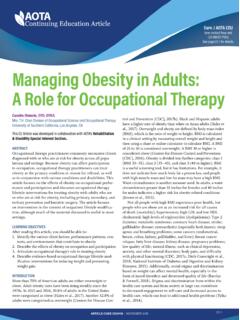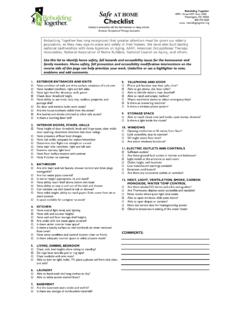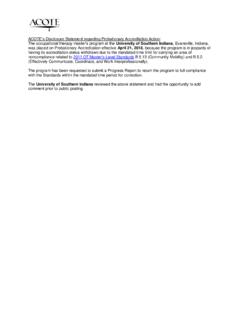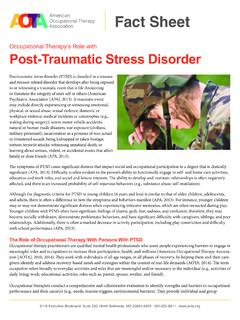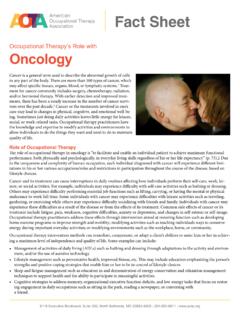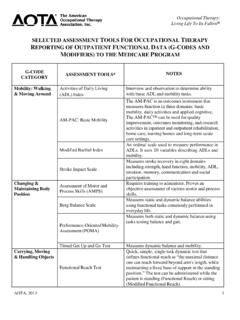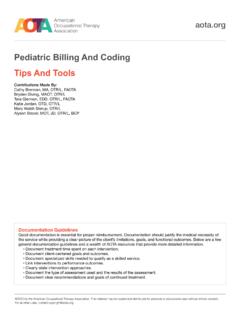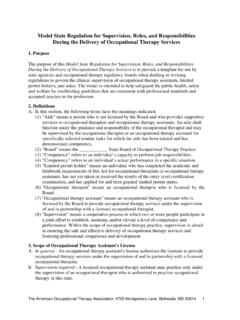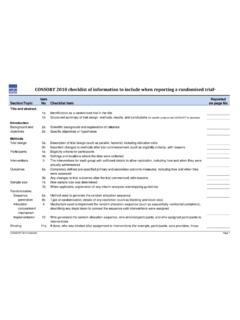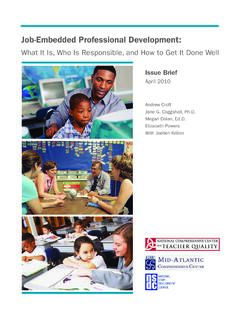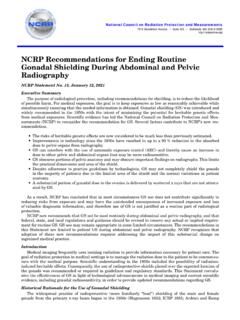Transcription of Choosing Wisely Handout - American Occupational Therapy ...
1 #1. Don t provide intervention activities that are non-purposeful ( , cones, pegs, shoulder arc, arm bike).Purposeful activities tasks that are part of daily routines and hold meaning, relevance, and perceived utility such as personal care, home management, school, and work are a core premise of Occupational Therapy . Research shows that using purposeful activity (occupation) in interventions is an intrinsic motivator for patients. Such activities can increase attention, endurance, motor performance, pain tolerance, and engagement, resulting in better patient outcomes.
2 Purposeful activities build on a person s ability and lead to achievement of personal and functional goals. Conversely, non-purposeful activities do not stimulate interest or motivation, resulting in reduced patient participation and suboptimal Ways to Make Your Workplace More Occupation-Friendly 1. Host an occupation drive. Make a wish list and share it with staff, asking them to donate their unused household items such as kitchen, housekeeping, or craft Hold a monthly OT challenge. To start incorporating more occupation into your practice, choose a month to focus on purposeful activity.
3 Each week of the month, challenge colleagues to replace a non-purposeful intervention with an occupation-based activity ( , Week 1: No arm bike, Week 2: No shoulder arc, etc.).3. Take a time out from commonly used non-purposeful activities. Remove non-purposeful activities from the clinic. Prior to removal, brainstorm with peers on other ways to address the needs of the client that are more purposeful but would achieve the desired outcome ( , take all peg boards out of the clinic). Prior to removal, list all the activities you could do that would achieve the same goal of increasing fine motor skills, such as taking strawberries out of a container one at a time and rinsing them in the sink, picking coins out of a purse or cup, opening a lipstick tube, taking the lid off of deodorant, eating finger foods, using the ATM, removing a cell phone from a pocket or purse, dialing a phone number or sending a text).
4 4. Use available resources from other areas within the facility. For example, ask the dietary staff if clients can help dry trays, restock paper items, or have supplies to make simple meals ( , sandwiches, fruit salads). Ask the housekeeping department if you can borrow vacuums, brooms, mops, and other cleaning supplies so that a client might use them to clean their own room or their area within a shared room. Ask nursing assistants to allow clients assist with or change their own bedding and put away their own personal items.
5 The maintenance staff may have tools or other items to borrow for clients to engage in mechanical tasks. The administrative staff may have small projects that clients could assist with, such as changing out the announcement boards, making announcements, folding flyers, and posting flyers. This work was developed by Brandy Brown, OTD, OTR/L, and Stephanie Bachman, OTD, OTR/L, CHT, CLA. Copyright 2019 by the American Occupational Therapy Association. This material may be copied and distributed for personal or educational uses without written consent.
6 For all other uses, contact your client s goal is .. And their strengths are ..And barriers to the goal are ..Try ..Instead of ..Facilitate success while providing the just-right challenge with supports as needed ..To return to completing housekeeping tasks after a recent fallUses a front-wheeled walker for short-distance indoor mobility, has antigravity strength in UE, can reach above shoulder levelFatigues after 2 3 minutes of standing or ambulation, has limited sustained UE strength, has a recent fall historyWashing, drying, and folding laundry; hanging clothes in a closet.
7 Making a snack or cup of coffeeAn arm bike to increase functional enduranceA gait belt for balance, verbal cues, grade by providing physical assistance for reaching or to decrease item weight; keep a chair nearby so the client can take breaks as needed or complete some tasks while seated; educate in energy conservation and work simplificationTo complete grooming after a strokeVery motivated, can tolerate sitting at a table or sink, can stand with minimal assistance for 1 minuteDecreased hand strength and coordinationRetrieving grooming items from toiletry kit and arranging on a table, combing hair, shaving, reaching to turn water on and offA peg board to improve fine motor skillsHand-over-hand assistance; grading difficulty of activity components (strength, fine motor coordination).
8 Using client s prior hobbies or interests, grade or adapt to improve fine motor control or strength and progress to translating to grooming activitiesTo complete self-feeding independently after a spinal cord injuryTenodesis grasp, AROM for shoulder and elbowDecreased hand strength and coordination; decreased wrist ROMU sing pretzel rods to make chocolate-covered pretzels, brushing teeth with an adaptive brush, opening a variety of containers using adaptive techniques, rolling out cookie or bread dough, doing simple meal prep with adaptive devicesA peg board and Therapy putty exercises to increase hand strength and coordinationIncorporate preparatory activities using tenodesis grasp and release in the clinic to increase confidence.
9 Use AAROM or hand-over-hand assistance, gradually decreasing support over timeTo increase standing balance (static and dynamic) for participation in IADLsCan stand with contact guard assistance for 5 minutes before resting, can walk with minimum assistance with FWW or hemi-walker or caneLoses balance (can be in any direction based on diagnosis)Obtaining items from kitchen to prepare a simple meal, gardening (planting, watering, weeding), putting dishes away, retrieving bird feeders and refilling feedBall toss, balloon toss, playing cards, puzzles Assist client to identify personal signs of fatigue or activities that trigger loss of balance ( , distraction from someone speaking to client) and appropriate techniques for managementNote.
10 AROM = active range of motion; AAROM = active assisted range of motion; FWW = front-wheeled walker; IADLs = instrumental activities of daily living; ROM = range of motion; UE = upper Wisely Recommendation References1. American Occupational Therapy Association. (2014). Occupational Therapy practice framework: Domain and process (3rd ed.). American Journal of Occupational Therapy , 68(Suppl. 1), S1 S48. Hinojosa, J., & Blount, M. (Eds.). (2017). The texture of life: Occupations and related activities. Bethesda, MD: AOTA Press.
